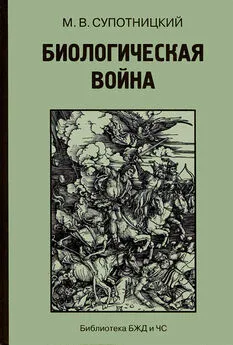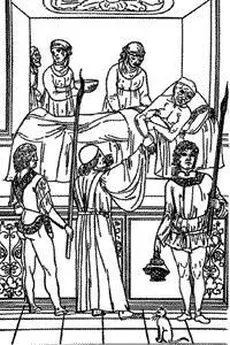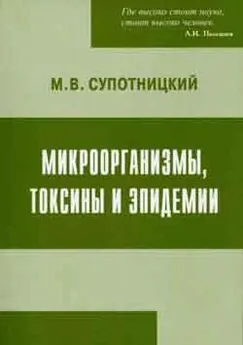Михаил Супотницкий - Биологическая война (Часть 3)
- Название:Биологическая война (Часть 3)
- Автор:
- Жанр:
- Издательство:Кафедра, Русская панорама
- Год:2013
- Город:Москва
- ISBN:978-5-93165-328-0
- Рейтинг:
- Избранное:Добавить в избранное
-
Отзывы:
-
Ваша оценка:
Михаил Супотницкий - Биологическая война (Часть 3) краткое содержание
Часть 3. Частная неправильная эпидемиология.
Биологическая война (Часть 3) - читать онлайн бесплатно полную версию (весь текст целиком)
Интервал:
Закладка:
Kiempner M. S, Talbot E. A., Lee S. I. etcl. Case records of the Massachusetts general hospital. Case 25-2010. A 24-year-old woman with abdominal pain and shock // N. Engl. J. Med 2010. V. 363. P. 766–777.
Klenerman P., Zinkemagel R. M. Original antigenic sin impairs cytotoxic T lymphocyte responses to viruses bearing variant epitopes // Nature. 1998. V. 394. P. 482–485.
Knight А. Н., Wynne-Williams J. Е., Willis А. Т. Cutaneous antlirax-the non-industrial hazard // Brit. med. JY. 1969. № 1 P. 416–418.
Ko J., Splitter G. Molecular host-pathogen interaction in Brucellosis: current understanding and future approaches to vaccine development for mice and humans // Clin Microbiol. Rev. 2003. V. 16, Nb 1. P. 65–78.
Koehler T.M., Thorne C.B. Bacillus subtilis (natto) plasmid pLS20 mediates interspecies plasmid transfer // J. Bacteriol. 1987. V. t69. № 11. P. 5271–5278.
Köhler S., Michaux-Charachon S., Porte F et al. What is the nature of the replicative niche of a stealthy bug named Brucella? // Trends Microbiol. 2003. — V. 11 P. 215–219.
Kool J. L. Risk of person-to-person transmission of pneumonic plague // Healthcare epidemiol. 2005. V. 40. P. 1166–1172.
Kortepeter М., Christopher G, Cieslak T. et al. USAMRIID’s medical management of biological casualties. Handbook. Forth Edition Editors. US Army Medical Research Institute of Infectious Diseases (USAMRIID), Fort Detrick, Maryland, 2001.
Kozminsky-Atias A., Bar-Shalom A., Mishmar D. et al. Assembling an arsenal, the scorpion way // BMC Evolution. Biol. 2008. V. 8 333 (http://www.biomedcentral.com/1471-2148/8/333).
Kreil T. R., Eibl М. M. Pit- and postexposure protection by pass.ve immunoglobulin but no enhancement of infection with a flaviviras in a mouse model // J. Viror. 1997. V. 71. № 4. P. 2921–2927.
Kreitman R. J. Immunotoxins for targeted cancer therapy // The AAPS J. (http://www.aapsj.org). 2006. V. 8. № 3. E532- F551.
Kreitman R. J. Recombinant immunotoxins containing truncated bacterial toxins for the treatment of hematologic malignancies // BioDrugs. 2009. V. 23. № 1. P. 1–13.
Kroca M., Tarnvik A., Sjostedt A. The proportion of circulating gammadelta T cells increases after the first week of onset of tularaemia and remains elcvateo for more than a year // Clin. Exp. Immunol. 2000. V. 120 P. 280–284.
Krug H. F., Wick P. Nanotoxicology: an interdisciplinary challenge // Angew. Chem. Int. Ed. Engl. 2011. V. 50. P. 1260–1278.
Kudo Y., Yasumoto Т., Konoki K. et al. Isolation and structural determination of the first 8-epitype tetrodo-toxin analogs from the newt. Cynups ensicauda popei, and comparison of tetrodutoxin analogs profiles of this newt and the puffer fish, Fugu poecilonotus // Mar. Drugs. 2012. V. 10. P. 655–667.
Kuiper-Goodman Т., Scott P. M. Risk assessment of the mycotoxin ochratoxin A // Biomed. Enviion. Sci. 1989. V. 2. P. 179–248.
Kuruba R., Wilson F., Gao X. et al. Targeted delivery of nucleic acid-based therapeutics to the pulmonary circulation // A^PS J. 2009. V. 11. № 1 P. 23–30.
La Scola B., Audtc S., Robertj tC. et al. A giant virus in amoebae // Science, 2003. V. 299. № 5615 P. 2033.
La Scola B., Elkarkouri K., Li W et al. Rapid comparative genomic analysis for clinical microbiology: The Francisella tularensis paradigm // Genome Res. 2008. V. 18. P. 742–750.
La Scola В, Raoult D. Survival of Coxiella burnetii within free-living amoeba Acanthariueba castellanii // Clin Microbiol. Infect. 2001. V. 7. P. 75–79.
Lacy D. B., Lin H., Melnyk R. A. et al. A model of anthrax toxin lethal factor bound to protective antigen // Proc Natl. Acad Sci. USA. 2005. V. 102. P. 16409-16414
Lacy D. B., Lin H., Melnyk R. A. et al. A model of anthrax toxin lethal factor bound to protective antigen // Proc Natl. Acad. Sci. USA. 2005. V. 102. P. 16409-16414.
Lai X. H, Golovliov I., Sjostedt A. Francisella tularensis induces cytopathogenicity and ape ptosis m murine macrophage: viaamechamsm that requires intracellular bacterial multiplication // Infect. Immun. 2001 V. 69. P. 4691–4694.
Latitha М., Thomas M. Penicillin resistance in Bacillus anthracis // Lancet. 1997. V. 349. Nb 9064. P. 1522.
Lamanna G. Immunological aspects of airborne infection some general consideration of response to inhalation of toxins // Bad, Reviews. 1961. V. 25. Nb 3. P. 323–330.
Lamb K., Lokesh G. L., Sherman M. et al. Structure of a Venezuelan equine encephalitis virus assembly // Virology. 2010. V. 406. № 2. P. 261–269.
Lancaster М. C., Boulter E. A, Westwood J. C. N. et al. Experimental respiratory infection with poxviruses. II Pathological studies // Br. J. Exp. Pathol, 1960. V. 47. № 5. P. 466–471.
Lanciott, R. S., Roehrig J. Т., Deubel Vet al. Origin of the West Nile virus responsible for an outbreak of encephalitis in the Northeastern United States // Science, 1999. V. 286. P. 2333–2337.
Lasaro M. L., Ertl H. New insights on adenovirus as vaccine vectors // Mol. Ther 2009. V. 17. Ns 8. P. 1333–1339.
Laskawi R. The use ofbotuhnum toxin in head and face medicine: An interdisciplinary field // Head & Face Medicine. 2008. V. 4. № 5 (doi:10.1186/1746-160X-4-5).
Lauriano С. М., Barker J. R., Yoon S. S. et al. MgIA regulates transcription of virulence factors necessary for Francisella tularensis intraamoebae and intramacrophage survival // Proc. Natl. Acad. Sci. USA. 2004. V. 101. P. 4246–4249.
Lazar Adler N. R., Stevens J., Stevens M. et al. Autotransporters and their role in the virulence of Burkholderia pseudomallei and Burkholderia mallei I 1 2011. V. 2. Article 151 (www.frontiersin.org.).
Leaf H. Патент 96/27393 (Al) ВОИС, МПК 6А61К38/17; A61K48/00; A61K9/127; A61K38/17; А61К48/ 00; A61K9/127. A dn powder formulation for gene therapyзаявитель Huang Leaf; пате» гооблада-тель Univ. Pittsburgh, США; заявл. 07.03.1995,08/400,089; опубл. 12.09.1996.
Le Duc J. М., Damon I., Meegan J. M. et al. Smallpox research activities: U. S. Interagency collaboration // Emerg. Infect. Dis. 2002. V. 8. № 7. P. 743–745.
Lee A. М., Pasquato A., Kunz S. Novel approaches in anti-arenaviral drug development // Virology. 2011. V. 411. № 2. P. 163–169.
Lee E., Harris. D. J., Siegel J. et al. Патент США 5840710 (А), МПК A61K47/48; A61K48/0C; A61K9/127; C07J41/00; C07J43/00; C12N15/88. Catior.ic amphiphiles containing ester or ether-linked lipophilic groups for intracellular delivery of therapeutic molecules, заявитель Genzyme Corp., США; заявл. 20.10.1995, 546087; опубл. 24.11 1998.
Leenderrz F. H., Yumlu S., Pauli G. et al. A new Bacillus anthracis found in wild chimpanzees and a gorilla from West and Central Africa // PLoS Pathogens 2006. V. 2 № 1. P. f -4.
Leepom A., Yongyod S., Yungyuen T. et al. Emergence of Francisella novicida bacterem ia, Thailand // Emerg. Infect. Dis. 2008. V. 14. № 12. P. 1935–1937
Lemichez E., Flatau G., BruzzoneM. et al. Molecular localization of the Escherichia coli cytotoxic necrotizing factor CNF1 cell-binding and catalytic domains // Mol. Microbiol. 1997. V. 24. № 7. P. 1061–1070.
Leung K., Fong B., Tsoi Yeuk-Ki Analytical challenge: determination of tetrodotoxin in human urine and plasma by LC-MS/MS // Mar. Drugs. 2011. V. 9. P. 2291–2303.
Levine R. S., Peterson A. Т., Yorita K. L. et al. Ecological niche and geographic distribution of human monkeypox m Africa // PLoS ONE. 2007. V. 2 (№ 1: el76. doi.10.1371/journal.pone.0000176).
Levy A., Chang В. J., Abrsott L. K. et al. Invasion of spores of the arbuscular mycorrhizal fungus Gigaspora decipiens by Burkholderia spp. // Appl. Environ. Microbiol. 2003. V. 69. P. 6250–6256.
Li N., Sioutas C., Cho A. et al. Ultrafine particulate pollutants induce oxidative stress and mitochondrial damage // Environ. Health. Perspect. 2003. V. 111. P. 455–460.
Li S., Huang L. Nonviral gene therapy: promises and challenges // Gene Thei 2000. V. 7. № 1. P. 31–34.
Li S., Tan Y., Viroonchatapan E. et al. Targeted gene delivery to pulmonary endothelium by anti-PECAM antiDody // Am. J. Physiol. Lung. Cell. Mol. Physiol. 2U00 V, 278, № 3. P. 504–511.
Li Y., Cui Y, Hauck Y. et al. Genotyping and phylogenetic analysis of Yersinia pestis by MLVA: insights into the worldwide expansion of Central Asia plague foe. // PLoS ONE. 2009. V. 4. № 6 (e6000.doi:10.1371/journal.pone.0006000).
Liepmann H. Death from the science. London, 1937.
Lindler L. E., Lebeda F. J., Korch G. W. Biological weapons defense. N. J., 2005
Lindstrom M., Korkeala H. Laboratory diagnostics ofbotulism // Clin. Microbiol. Rev. 2006. V. 19. P. 298–314.
Liu Chengchu, Zhu Qing, Wu Wenhuietal. Degradable copolymer based on amphiphilic N-octyl-N-quatenary chitosanand low-molecular weight polyethylenimine for gene delivery // Intern. J. of Nanomed. 2012. V. 7. P. 5339–5350.
Liu X. S., Dean D. H. Redesigning Bacillus thuringiensis CryI Aa toxin into a mosquito toxin // Prot Eng. Design. Selec. 2006. V. 19 P. 107–111.
Llewellyn L. E. Saxitoxin, a toxic marine natural product that targets a multitude of receptors // Nat. Prod. Rep. 2006. V. 23. P. 200 222
Lobet Y., Cieplak W., Smith S. G/ et al. Effects of mutations on enzyme activity and immunoreactivity of the SI subunit of pertussis toxin // Infec. Immun. 1989. V. 57 № 11. P. 3660–3668.
Lockman P. R., Koziara J. M., Mumper R. J. et at. Nanoparticle surface charges alter blood-brain barrier integrity and permeability // J. Drug Target. 2004. V. 12. P. 635–641.
Logan W. Mortality in the London fog incident, 1952 // Lancet. 1953. V. 1. P. 336–338.
Logue C. H., Bosio C. F., Welte T. et al . Virulence variation among isolates of western equine encephalitis virus in an outbred mouse // J. Gen. Virol. 2009. V. 90. P. 1848–1858.
Loosmore S, Zealy G. R., Boux H. A. et al. Engineering of genetically detoxified pertussis toxin analogs for development of a recombinant whooping cough vaccine // Infec. Immun. 1990. V. 58, № 5 P. 3653–3662.
Loparev V., Massung R., Esposito J. et al. Detection and differentiation of Old World orthopoxviruses: restriction fragment length polymorphism of the crmB gene region // J. Clin. Microbiol. 2001.V 39. № 1. P. 94–100.
lord M. J., Jolliffe N. A., Marsden C. J. et al. Ricin. Mechanisms of cytotoxicity // Toxicol. Rev. 2003. V. 22. R 53–64.
Lorenz М., WackernageI W. Bacterial gene transfer by natural generic transformation in the environment // Microbiol. Rev. 1994. V. 58. № 3. P. 563–602.
Louzao М., Ares I., Cagide E. Marine toxins and the cytoskeleton: a new view of palytoxin toxicity // FEBS Journal. 2008. V. 275. P. 6067–6074.
LоVullo E. D., Sherrill L. A., Pavelka M. S. Improved shuttle vectors for Francisella tuiarensis genetics // FEM S Microbiol. Lett. 2009 V. 291. № 1. P. 95–102.
Lukashevich I. S., Patterson J., Carrion R. et al. A live attenuated vaccine for Lassa fever made by reassortment of Lassa and Mopeia viruses // J. Virol. 2005. V. 79. № 22. P. 13934—13942.
Lurie M. D., Hoppleston A. G., Abramson S. et al. An evaluation of the method of quantitative air-borne infection and its use in the study of the pathogenesis // Am. Rev. Tubore. 1950. V. 61. P. 765–797.
Читать дальшеИнтервал:
Закладка:







![Михаил Супотницкий - Очерки истории чумы. Книга II. Чума бактериологического периода [без иллюстраций]](/books/1084186/mihail-supotnickij-ocherki-istorii-chumy-kniga-ii.webp)
![Михаил Супотницкий - Очерки истории чумы. Книга I. Чума добактериологического периода [без иллюстраций]](/books/1084187/mihail-supotnickij-ocherki-istorii-chumy-kniga-i-ch.webp)

